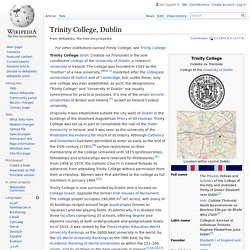

The Belfast Murals - Antrim, z_Top Ten Outside Dublin - Choose Ireland. The Belfast Murals Page last updated by Michael Heraghty on July 31, 2015 What I did: Added link to website with map of all murals.

The West Belfast areas of Shankhill Road and Falls Road are decorated with a variety of wall murals. These murals express the political loyalties of the people who live in the surrounding working class neighbourhoods. Yes, But Is It Art? Painted on homes and other buildings, the murals represent an art form as worthy of a guided tour as any museum in the country. Styles Some are ornate works of art, embellished and professional, while others impress viewers with minimal artistry and stark emotion.
Casino at Marino. Name[edit] The name 'Casino' is the diminutive form of the 18th-century Italian word 'Casa' meaning 'House', thus 'Little House',[3] and is not used in the modern sense of "gambling establishment".

After his 9-year Grand Tour of Italy and Greece, Caulfield was taken with all things Italian, and decided to add a 'little house'[4] to his estate, which he had already named after the town of Marino in Lazio.[5] Design[edit] Widely regarded as the most important Neo-Classical building in Ireland,[2] the Casino is actually quite small, measuring only fifty feet square to the outer columns. In plan, it takes the form of a Greek Cross with a pair of columns framing each projecting elevation. O'Connell Street. O'Connell Monument, the memorial to Daniel O'Connell, the 19th-century nationalist leader, by sculptor John Henry Foley, which stands at the entrance to the street named after him.

O'Connell Street (Irish: Sráid Uí Chonaill) is Dublin's main thoroughfare. It measures 49 m (160 ft) in width at its southern end, 46 m (150 ft) at the north, and is 500 m (1650 ft) in length. During the 17th century it was a narrow street known as Drogheda Street (named after Henry Moore, Earl of Drogheda). Merrion Square. Georgian façade of Merrion Square, Dublin.
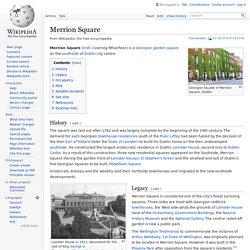
General Post Office, Dublin. The General Post Office (GPO; Irish: Ard-Oifig an Phoist) in Dublin is the headquarters of the Irish Post Office, An Post, and Dublin's principal post office.

Sited in the centre of O'Connell Street, the city's main thoroughfare, it is one of Ireland's most famous buildings, and was the last of the great Georgian public buildings erected in the capital. Architecture[edit] History[edit] The Famine Memorial and The World Poverty Stone - Dublin Docklands. The Famine Memorial 'Famine' (1997) was commissioned by Norma Smurfit and presented to the City of Dublin in 1997.
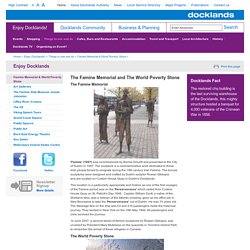
The sculpture is a commemorative work dedicated to those Irish people forced to emigrate during the 19th century Irish Famine. The bronze sculptures were designed and crafted by Dublin sculptor Rowan Gillespie and are located on Custom House Quay in Dublin's Docklands. This location is a particularly appropriate and historic as one of the first voyages of the Famine period was on the 'Perserverance' which sailed from Custom House Quay on St.
Patrick's Day 1846. Valentia Transatlantic Cable Station. A brief history Prior to the laying of the Transatlantic Cable it took approximately two weeks from a message to reach North America from Europe… weather permitting as all communications were sent via boat.
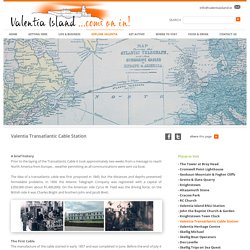
The idea of a transatlantic cable was first proposed in 1845, but the distances and depths presented formidable problems. In 1856 the Atlantic Telegraph Company was registered with a capital of £350,000 (then about $1,400,000). On the American side Cyrus W. Field was the driving force; on the British side it was Charles Bright and brothers John and Jacob Brett. The Chester Beatty Library website, gallery, exhibition, collection. War Memorial Gardens. Contact Details Address: Islandbridge, Dublin 8Telephone No: +353 1 475 7816 (gardens)Fax No: +353 1 475 5287Email: info@heritageireland.ie Directions: Please click here.
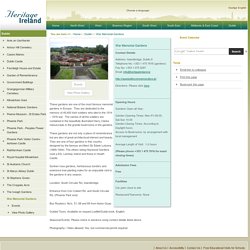
Opening Hours Gardens Open all Year: Garden Opening Times: Mon-Fri 08.00, Sat-Sun 10.00Garden Closing Times: According to Daylight hoursAccess to Bookrooms: by arrangement with local management Average Length of Visit: 1-2 hours (Please phone +353 1 475 7816 for exact closing times) Admission Fees Free Facilities Car park close to site Restaurant/Tearooms: None These gardens are one of the most famous memorial gardens in Europe. These gardens are not only a place of remembrance but are also of great architectural interest and beauty. Sunken rose gardens, herbaceous borders and extensive tree planting make for an enjoyable visit to the gardens in any season.
Location: South Circular Rd, Islandbridge. Entrance from Con Colbert Rd. and South Circular Rd. Discover the National Gallery of Ireland and its Collections. National Museum of Ireland. Archaeology Kildare Street Dublin 2 Discover gold, bog bodies, ceramics, glass, Viking artefacts as well many other archaeological objects found in Ireland and around the world.

Visitor Information Visiting our Kildare Street site? Read our tips to get the most from your trip Exhibitions Browse our exhibition galleries to find treasures from the past. What's On? See listings for Archeology related events and exhibitions. Explore & Learn - Archaeology Our Education team bring you the best activities and resources for schools, teachers, families and groups visiting Kildare Street Antiquities Collections.
The Little Museum of Dublin. The Office of Public Works. Trinity College, Dublin. Coordinates:
